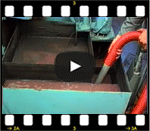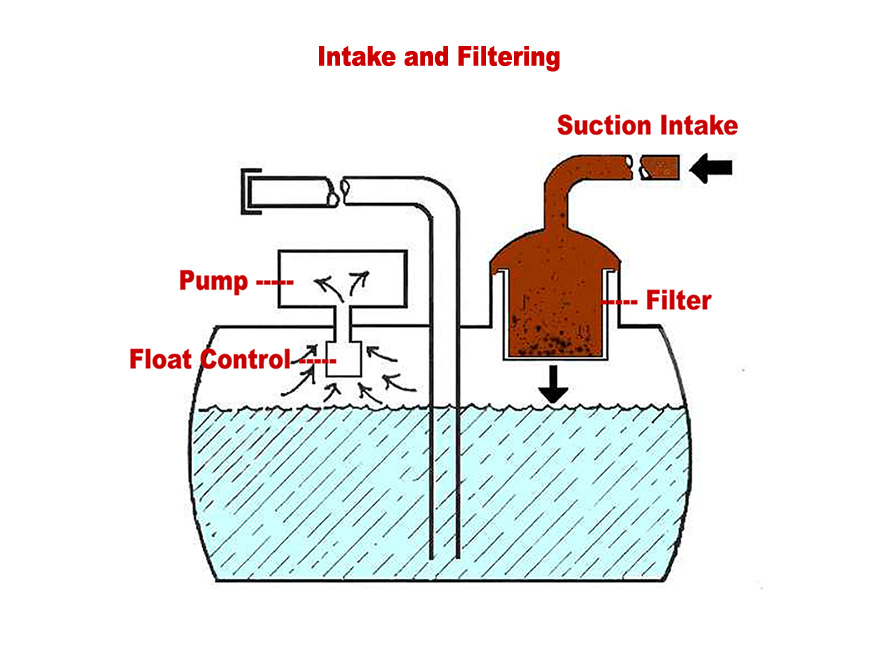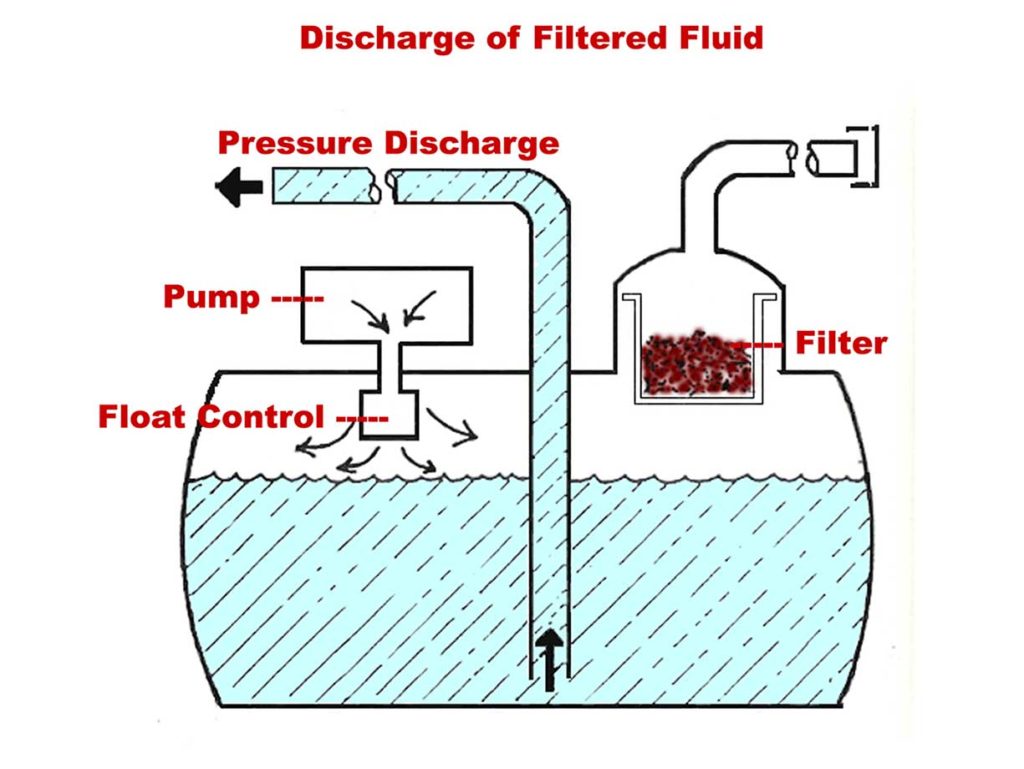A sump cleaner, sometimes called a sump sucker, is a specialized tool for cleaning the coolant sumps of machine tools. The sump contents usually consist of coolant and solids. The solids consist of metal chips and swarf. In just a few minutes, a sump cleaner will pick up everything in the sump – fluid as well as solids. The filter separates the solids from the fluid. Filtered coolant is returned to the machine tool sump or transported for additional processing.
Click the “Play” button to watch the CECOR® sump cleaner in action.
Clean coolant lasts longer. Buy less coolant. Increasing costs for the purchase, use and disposal of coolant have made extending the life of coolant very important to metalworking shops. An important part of cleaning coolant is filtration or solids separation. Filtration involves passing coolant through a porous material that will remove the chips, swarf and fines.
Metal chips in the coolant can mar the workpiece. One of the functions of coolant is to wash the 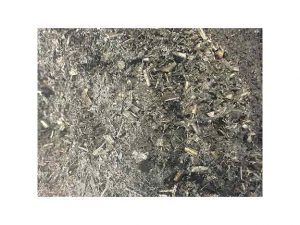 metal chips away from the machine tool and cutting area. The chips and fines follow the coolant to the sump where most settle. Those remaining are recirculated through the machine and can damage the workpiece by marring the finish.
metal chips away from the machine tool and cutting area. The chips and fines follow the coolant to the sump where most settle. Those remaining are recirculated through the machine and can damage the workpiece by marring the finish.
Chips and fines in sumps cause microbial growth leading to stinky coolant and dermatitis. Most chips and fines settle to the bottom of the sump forming a sludge. This sludge promotes bacterial and fungal growth. Biocides added to the coolant to control the growth of bacteria do not reach the coolant that is mixed with the sludge at the bottom of the sump.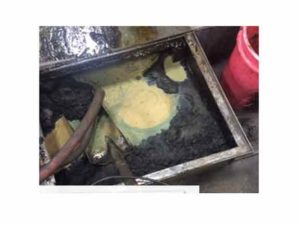
Failure to remove the chips and fines can reduce the sump volume. Some of the water in water-based coolant is lost by evaporation. Coolant is also lost when it is carried out on parts. Chips and fines settle in the sump, making the sump continue to appear full, even though the volume of coolant moving through the machine has been reduced.
Excessive solids can cause increased fluid temperature. Less coolant moving through the machine, means less time spent cooling in the sump. Fluid is pumped back through the machine quicker resulting in higher coolant temperatures. Also, solids have different heat transfer properties than coolant.
Excessive solids may deplete coolant ingredients – coolant is not as effective. Among the ingredients added to coolant are rust inhibitors, fungicides and biocides, wetting agents, emulsifiers and coalescents. Solids may absorb desirable ingredients and lessen their effectiveness. Many of these problems can be eliminated or greatly reduced by cleaning the sump regularly. CECOR sump cleaners deliver high-suction lift to remove all solids in the coolant sump along with the metalworking fluid. The filter separates solids from the coolant for re-use right at the machine tool. Filtered coolant is pumped back into the sump in minutes.
Save labor co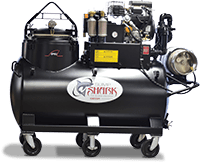 sts and reduce downtime. A pail and shovel or the machine’s internal coolant pump may seem like the cheapest way to clean a sump, but when you consider the hours (or perhaps even days) needed for an employee to do a thorough job, the costs mount quickly. By using a CECOR sump cleaner you can save money two ways. Save labor costs. How much are you paying that employee per hour? High-suction lift from a CECOR sump cleaner sucks the sludge and the muck out fast…much faster than a shovel. Reduce machine downtime. How much production time and money do you lose when the machine tool sits idle? A CECOR sump cleaner will reduce machine downtime to a minimum.
sts and reduce downtime. A pail and shovel or the machine’s internal coolant pump may seem like the cheapest way to clean a sump, but when you consider the hours (or perhaps even days) needed for an employee to do a thorough job, the costs mount quickly. By using a CECOR sump cleaner you can save money two ways. Save labor costs. How much are you paying that employee per hour? High-suction lift from a CECOR sump cleaner sucks the sludge and the muck out fast…much faster than a shovel. Reduce machine downtime. How much production time and money do you lose when the machine tool sits idle? A CECOR sump cleaner will reduce machine downtime to a minimum.
Improve Employee Morale It sure beats a pail and shovel. When sump cleaning is easier and faster, it will get done more often. With regular cleaning the build-up of impacted swarf and layers of scum in the sump will not occur and the job will be more pleasant and faster. Regular sump cleaning will reduce the odor and mess in and around machine tools and reduce the risk of dermatitis, making for an overall cleaner and more productive work setting
Vacuum Lift…How a Sump cleaner works.
Long before a child can pronounce “atmospheric vacuum” he has learned a great deal about how it works through experience with soda straws. He discovers very quickly, for example, that small straws are fine for soft drinks, but that larger straws are better for thick milk shakes. He knows that when his mouth is full, the flow cuts off automatically. He learns that thick fluids call for harder sucking, and that he must keep the bottom of the straw unobstructed by solid matter, and that if he is to avoid the snorkling noise, he must keep the bottom of the straw submerged. Nature abhors a vacuum. Chances are he couldn’t care less that this principle of vacuum lift is used in removing oil and suspended sludge in machine tool sump tanks. What appears to be a fluid-sucking action sets up atmospheric differentials which cause room air to force fluids through a tube to an area where less pressure exists. The speed with which a fluid will travel from the high to the low side of the pressure zone is determined by
- Diameter of the suction tube.
- Viscosity of the fluid.
- Distance from intake to exit ports.
- Ability of the suction system to maintain vacuum at a constant level.
This means for optimum performance, heavier sludges require deeper vacuum, larger diameter suction hoses, and short- coupled hose length to reduce frictional drag as the sludge moves from the machine sump to a storage tank.
Intake and Filtering of Dirty Coolant
Figure 1 shows how a sump cleaner works on the suction cycle for removing liquids and solids from the sump. The pump generates a deep vacuum in the tank. The tank is open to the atmosphere through the suction hose which draws the liquids and solids from the sump directly into the tank. The coolant never contacts the pump. A Float Control prevents overfill and protects pump unit against liquid entry.
Pressure Discharge of Filtered Dirty Coolant
Figure 2 shows how a sump cleaner can generate pressure in the tank using the same pump configuration. Although the pressure is less than 10 psi, is is sufficent for quick and easy emptying of the tank through the discharge port.
The vacuum lift in a sump cleaner is superior to wet/dry vacuums. In fact, the vacuum is measured differently. With wet/dry vacs, the vacuum lift is measured in inches of water, sump cleaners in inches of mercury. A good wet/dry vac can generate 90 inches of water or 6.6 inches of mercury (Hg). A good sump cleaner will generate between 160” and 360” of water (12” to 26” (Hg) mercury) which is at least twice that of a wet/dry vac. With the increased suction lift, a sump cleaner will be able to lift and remove even the heaviest of sludge in the bottom of the sump. Wet/dry vacuums need air to cool the motor. Without air moving through the hose, the motor will overheat and burn out. A sump cleaner is designed to work with the hose totally submerged in the fluid. Sump cleaners are designed and built for cleaning machine tool sumps. Use the right equipment for the job. Compare sump cleaner with wet/dry vac:
| Sump Cleaner | Wet/Dry Vacuum | |
| Attributes | Deep-suction lift with low-nozzle air flow. | Low-suction lift with high-nozzle air flow. |
| Use | Used for picking up pools of liquid, submerged sludge and viscous liquids in concentrated areas. | Used for picking up dry substances and puddles or shallow spills of liquid. Total submersion in liquid will cause motor to burn out. |
| Ratings | Suction lift measured in inches of mercury (Hg) and pump rate measured in GPM (gallons per minute). | Suction lift in inches of water and air movement measured in CFM (cubic feet per minute). |
Continuous loop systems’ claim is that you never have to shut down the machine tool. Well, instead of changing the oil and oil filter in your car, would you just change the filter? No. Using continuous loop systems is like only changing your oil filter. These expensive units may slightly improve coolant life but do not solve the complete problem. The sludge and solids in the bottom of the sump are not removed. These systems clean the surface area of the sumps, but do not address the sludge and solids that lie at the bottom. Coolant recycling takes commitment. It does not have to be expensive, but it is not always easy. First you start with quality coolant, monitor the coolant mix, completely clean the sump on a regular basis and remove the tramp oil.
CECOR has designed and manufactured its own coolant sump cleaner line since 1955 (the longest in the industry). Coolant maintenance equipment is our main focus. Our experience has enabled us to design the most efficient sump cleaners for cleaning machine tool sumps. We use only high-quality components, such as long-wearing, chemically-resistant industrial pumps, hoses, valves and wheels. CECOR offers the broadest line of sump cleaners to fit a wide range of applications. Here are a few features that make CECOR sump cleaners unique:
- Vacuum/pressure gauges to prevent over pressurization.
- Units have multiple backup pressure relief systems. Air units include a rupture disk as an additional safety feature.
- All discharge ports have a valve to prevent accidental spills and to control the discharge of coolant from the sump cleaner.
- Feature a flush to the tank bottom clean-out door to make clean up easier.
- Patented filter system features a reverse taper design to prevent bridging. The filter is narrower at the top and wider at the bottom. This prevents solids from becoming trapped in the filter. The filter empties completely.
- Unique filter pack design features a continuous reusable filter membrane unbroken by slits or openings. Some competitive sump cleaners have slits in their filter membranes to accommodate lifting eyes located inside the basket and may also have an open bottom. If the coolant can bypass the filter through even the smallest opening, it is not being filtered.
- Use of a mechanical (non-electric) overflow control valve to protect against spills and air pump damage. We do not use electrical overflow controls in order to prevent electrical components from coming in contact with fluid and to insure dependable operation in all coolant/oil environments.
- Qualified support people to help you with a full line of stocked repair parts for immediate shipping.
CECOR is able to provide high-quality sump cleaners at competitive prices because our focus is designing and building sump ccleaners. This focus allows us to buy and build with maximum efficiency. Download ROI calculator and calculate your coolant savings today!


